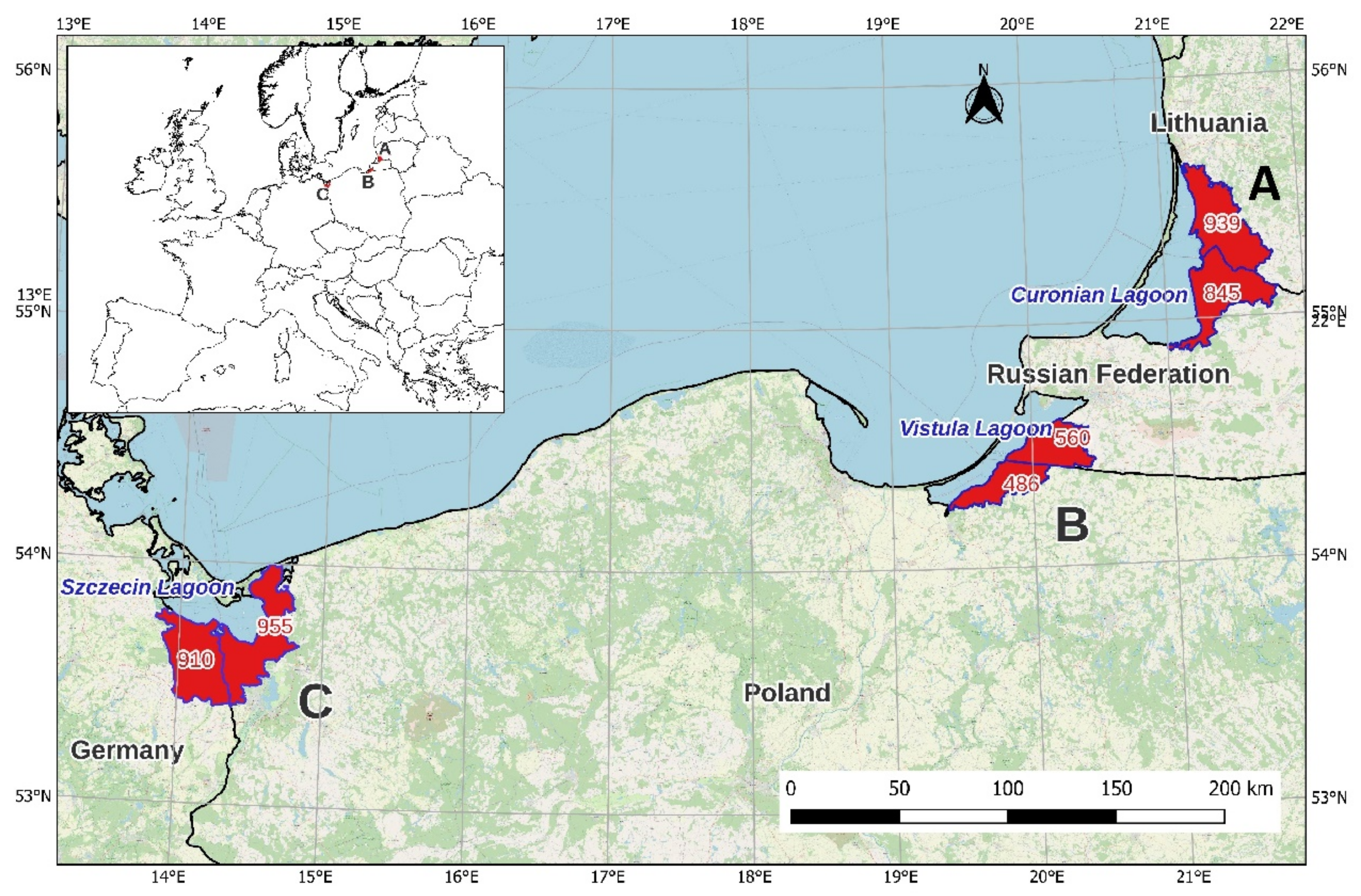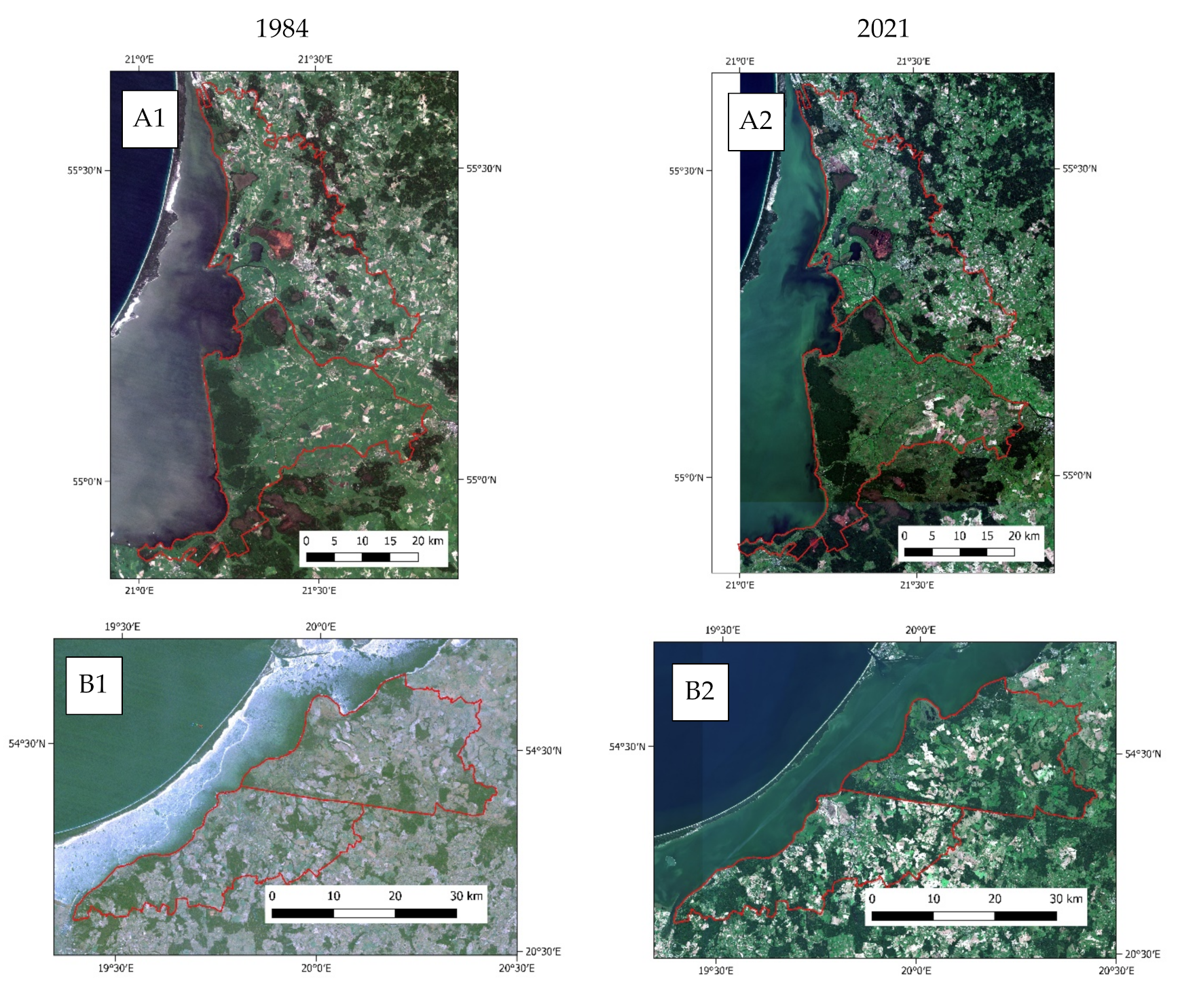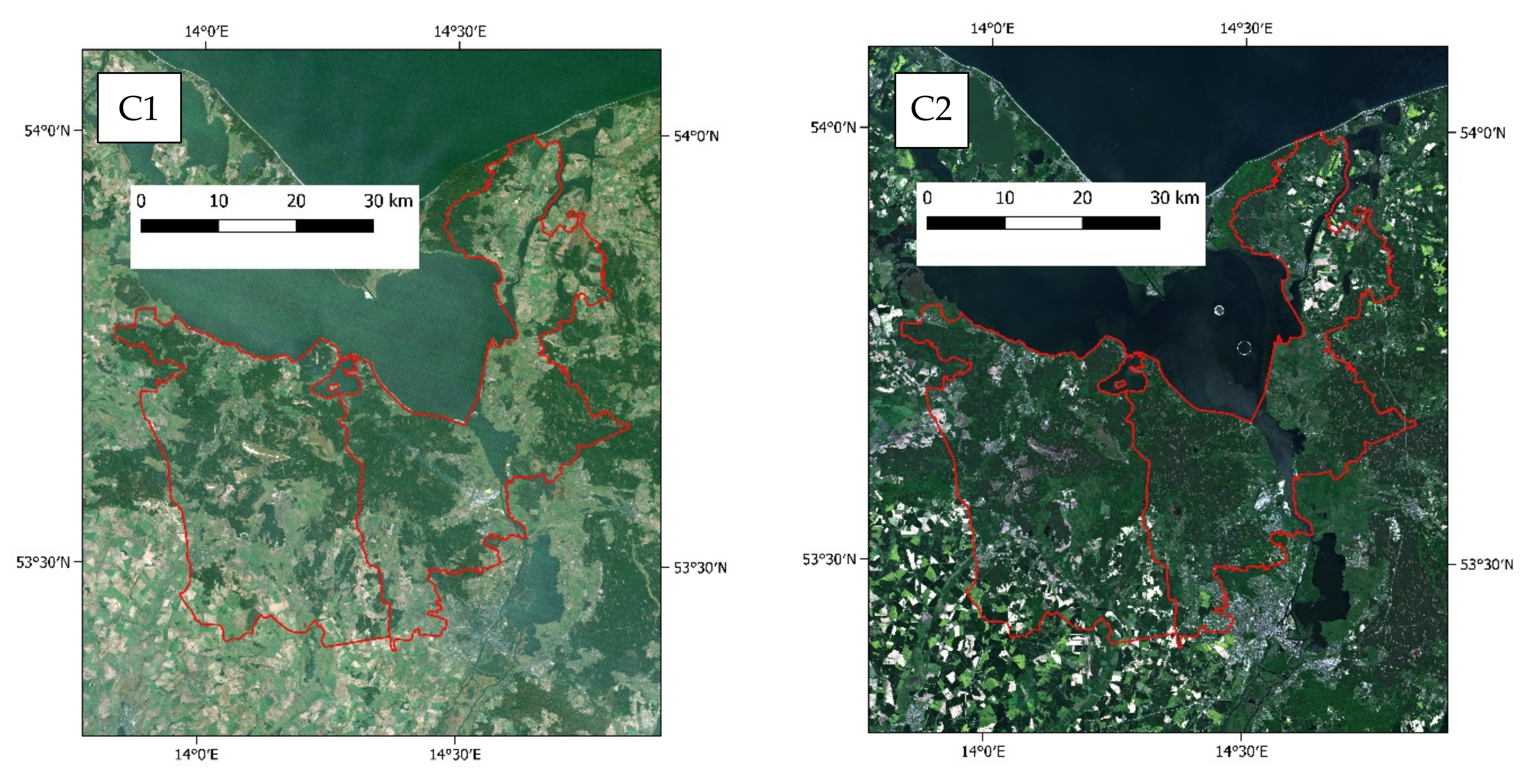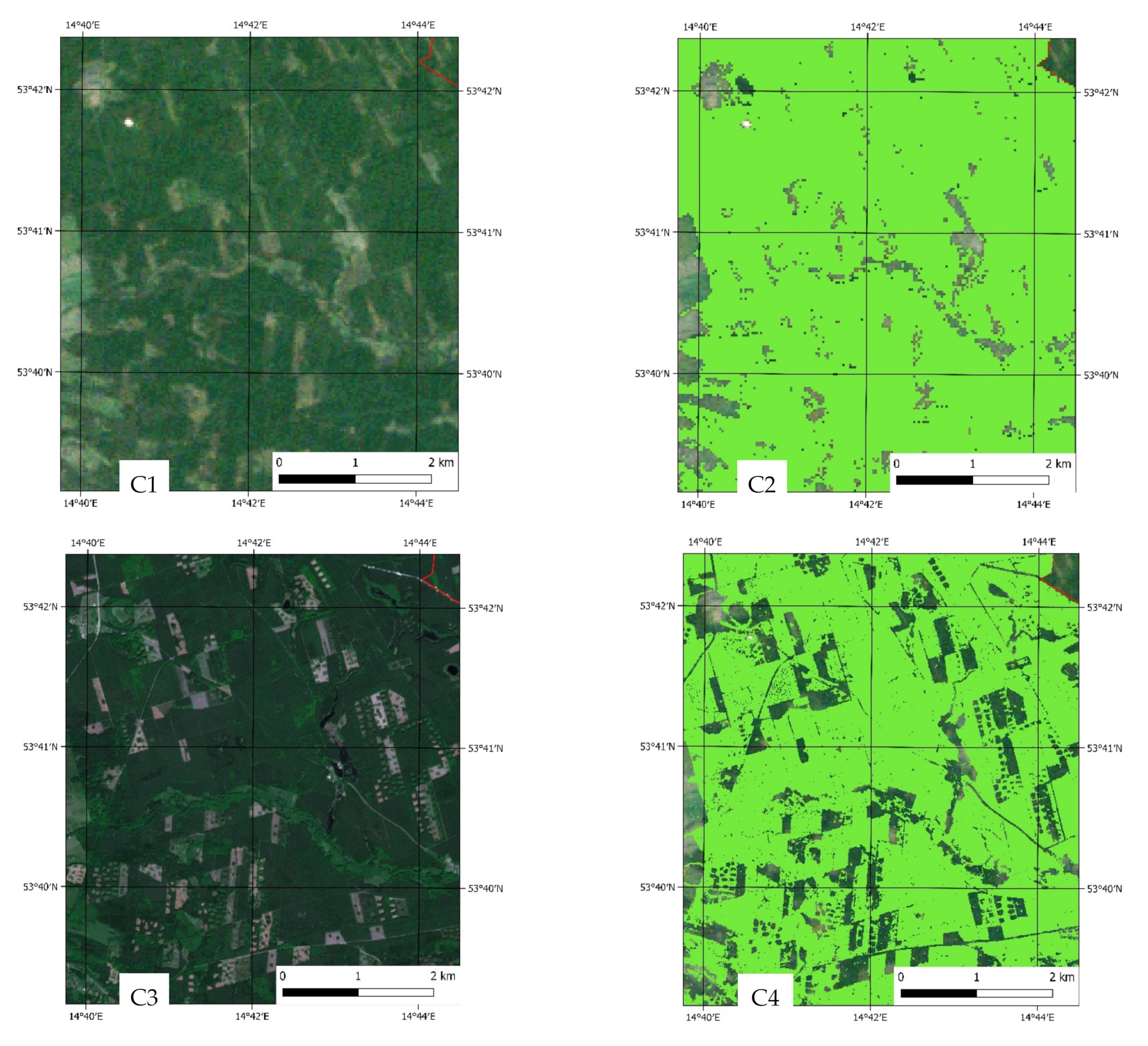Land Cover Changes in Selected Areas Next to Lagoons Located on the Southern Coast of the Baltic Sea, 1984–2021
Abstract
:1. Introduction
2. Materials and Methods
2.1. Studied Area
2.2. Methods Used of Land Cover Classification
- -
- download of the satellite images and selection of completely cloudless images;
- -
- merging (if necessary) satellite scenes;
- -
- calculation of spectral indices (NDVI) using QGIS software (raster calculator tool);
- -
- preparation of multiband rasters (R, G, B, NIR and NDVI);
- -
- preparation of vector layers with sample training areas for main land cover types based on visual assessment and previous studies (CORINE Land Cover and Geo-harmonizer projects) for each location and date separately (for each cover type at least 10 training polygons were selected);
- -
- generation of Esri classifier definition files (.ecd) for each location and date (separately for each satellite sensor);
- -
- performing classification using Random Trees Classifier in ArcGIS (random forest algorithm) and generation of the rasters with land cover types;
- -
- calculation of area of forests and water bodies using raster calculator and zonal statistics in QGIS software.
3. Results
3.1. Changes in Forest Area
3.2. Changes in Inland Water Reservoirs
4. Discussion
5. Conclusions
Supplementary Materials
Author Contributions
Funding
Institutional Review Board Statement
Informed Consent Statement
Data Availability Statement
Conflicts of Interest
References
- Kharazmi, R.; Tavili, A.; Rahdari, M.R.; Chaban, L.; Panidi, E.; Rodrigo-Comino, J. Monitoring and Assessment of Seasonal Land Cover Changes Using Remote Sensing: A 30-Year (1987–2016) Case Study of Hamoun Wetland, Iran. Environ. Monit. Assess. 2018, 190, 356. [Google Scholar] [CrossRef] [PubMed]
- Brauman, K.A.; Daily, G.C.; Duarte, T.K.; Mooney, H.A. The Nature and Value of Ecosystem Services: An Overview Highlighting Hydrologic Services. Annu. Rev. Environ. Resour. 2007, 32, 67–98. [Google Scholar] [CrossRef]
- Hu, H.; Liu, W.; Cao, M. Impact of Land Use and Land Cover Changes on Ecosystem Services in Menglun, Xishuangbanna, Southwest China. Environ. Monit. Assess. 2008, 146, 147–156. [Google Scholar] [CrossRef] [PubMed]
- Rimal, B.; Sharma, R.; Kunwar, R.; Keshtkar, H.; Stork, N.E.; Rijal, S.; Rahman, S.A.; Baral, H. Effects of Land Use and Land Cover Change on Ecosystem Services in the Koshi River Basin, Eastern Nepal. Ecosyst. Serv. 2019, 38, 100963. [Google Scholar] [CrossRef]
- Shrestha, M.; Acharya, S.C. Assessment of Historical and Future Land-use–Land-cover Changes and Their Impact on Valuation of Ecosystem Services in Kathmandu Valley, Nepal. Land Degrad. Dev. 2021, 32, 3731–3742. [Google Scholar] [CrossRef]
- Yin, H.; Pflugmacher, D.; Li, A.; Li, Z.; Hostert, P. Land Use and Land Cover Change in Inner Mongolia—Understanding the Effects of China’s Re-Vegetation Programs. Remote Sens. Environ. 2018, 204, 918–930. [Google Scholar] [CrossRef]
- Saintilan, N.; Rogers, K.; Kelleway, J.J.; Ens, E.; Sloane, D.R. Climate Change Impacts on the Coastal Wetlands of Australia. Wetlands 2019, 39, 1145–1154. [Google Scholar] [CrossRef]
- Havens, K.; Jeppesen, E. Ecological Responses of Lakes to Climate Change. Water 2018, 10, 917. [Google Scholar] [CrossRef] [Green Version]
- Zou, Z.; Dong, J.; Menarguez, M.A.; Xiao, X.; Qin, Y.; Doughty, R.B.; Hooker, K.V.; David Hambright, K. Continued Decrease of Open Surface Water Body Area in Oklahoma during 1984–2015. Sci. Total Environ. 2017, 595, 451–460. [Google Scholar] [CrossRef]
- Thompson, R.B.; Incrocci, L.; van Ruijven, J.; Massa, D. Reducing Contamination of Water Bodies from European Vegetable Production Systems. Agric. Water Manag. 2020, 240, 106258. [Google Scholar] [CrossRef]
- Sinha, E.; Michalak, A.M.; Balaji, V. Eutrophication Will Increase during the 21st Century as a Result of Precipitation Changes. Science 2017, 357, 405–408. [Google Scholar] [CrossRef] [Green Version]
- Akber, A.; Khan, W.R.; Islam, A.; Rahman, M.; Rahman, M.R. Impact of Land Use Change on Ecosystem Services of Southwest Coastal Bangladesh. J. Land Use Sci. 2018, 13, 238–250. [Google Scholar] [CrossRef]
- Yim, J.; Kwon, B.-O.; Nam, J.; Hwang, J.H.; Choi, K.; Khim, J.S. Analysis of Forty Years Long Changes in Coastal Land Use and Land Cover of the Yellow Sea: The Gains or Losses in Ecosystem Services. Environ. Pollut. 2018, 241, 74–84. [Google Scholar] [CrossRef]
- ZhiYong, L.; Liu, T.; Benediktsson, J.A.; Falco, N. Land Cover Change Detection Techniques: Very-High-Resolution Optical Images: A Review. IEEE Geosci. Remote Sens. Mag. 2021, 2–21. [Google Scholar] [CrossRef]
- Talukdar, S.; Singha, P.; Mahato, S.; Pal, S.; Liou, Y.-A.; Rahman, A. Land-Use Land-Cover Classification by Machine Learning Classifiers for Satellite Observations—A Review. Remote Sens. 2020, 12, 1135. [Google Scholar] [CrossRef] [Green Version]
- Gavade, A.B.; Rajpurohit, V.S. Systematic Analysis of Satellite Image-Based Land Cover Classification Techniques: Literature Review and Challenges. Int. J. Comput. Appl. 2021, 43, 514–523. [Google Scholar] [CrossRef]
- Phiri, D.; Morgenroth, J. Developments in Landsat Land Cover Classification Methods: A Review. Remote Sens. 2017, 9, 967. [Google Scholar] [CrossRef] [Green Version]
- O’Donnell, J.; Schalles, J. Examination of Abiotic Drivers and Their Influence on Spartina Alterniflora Biomass over a Twenty-Eight Year Period Using Landsat 5 TM Satellite Imagery of the Central Georgia Coast. Remote Sens. 2016, 8, 477. [Google Scholar] [CrossRef] [Green Version]
- Irons, J.R.; Dwyer, J.L.; Barsi, J.A. The next Landsat Satellite: The Landsat Data Continuity Mission. Remote Sens. Environ. 2012, 122, 11–21. [Google Scholar] [CrossRef] [Green Version]
- Lulla, K.; Nellis, M.D.; Rundquist, B.; Srivastava, P.; Szabo, S. Mission to Earth: LANDSAT 9 Will Continue to View the World. Geocarto Int. 2021, 36, 2261–2263. [Google Scholar] [CrossRef]
- Phiri, D.; Simwanda, M.; Salekin, S.; Nyirenda, V.; Murayama, Y.; Ranagalage, M. Sentinel-2 Data for Land Cover/Use Mapping: A Review. Remote Sens. 2020, 12, 2291. [Google Scholar] [CrossRef]
- Manakos, I.; Braun, M. (Eds.) Land Use and Land Cover Mapping in Europe: Practices & Trends; Remote Sensing and Digital Image Processing; Springer: Dordrecht, The Netherlands, 2014; Volume 18, ISBN 978-94-007-7968-6. [Google Scholar]
- Aune-Lundberg, L.; Strand, G.-H. The Content and Accuracy of the CORINE Land Cover Dataset for Norway. Int. J. Appl. Earth Obs. Geoinf. 2021, 96, 102266. [Google Scholar] [CrossRef]
- Gemitzi, A.; Albarakat, R.; Kratouna, F.; Lakshmi, V. Land Cover and Vegetation Carbon Stock Changes in Greece: A 29-Year Assessment Based on CORINE and Landsat Land Cover Data. Sci. Total Environ. 2021, 786, 147408. [Google Scholar] [CrossRef] [PubMed]
- Open Data Science Team Geo-Harmonizer. EU-Wide Automated Mapping System for Harmonization of Open Data Based on FOSS4G and Machine. Available online: https://maps.opendatascience.eu (accessed on 12 January 2022).
- Churches, C.E.; Wampler, P.J.; Sun, W.; Smith, A.J. Evaluation of Forest Cover Estimates for Haiti Using Supervised Classification of Landsat Data. Int. J. Appl. Earth Obs. Geoinf. 2014, 30, 203–216. [Google Scholar] [CrossRef] [Green Version]
- Li, C.; Wang, J.; Wang, L.; Hu, L.; Gong, P. Comparison of Classification Algorithms and Training Sample Sizes in Urban Land Classification with Landsat Thematic Mapper Imagery. Remote Sens. 2014, 6, 964–983. [Google Scholar] [CrossRef] [Green Version]
- Long, J.B.; Giri, C. Mapping the Philippines’ Mangrove Forests Using Landsat Imagery. Sensors 2011, 11, 2972–2981. [Google Scholar] [CrossRef] [Green Version]
- Zhang, Y.; Lu, D.; Yang, B.; Sun, C.; Sun, M. Coastal Wetland Vegetation Classification with a Landsat Thematic Mapper Image. Int. J. Remote Sens. 2011, 32, 545–561. [Google Scholar] [CrossRef]
- Sun, C.; Fagherazzi, S.; Liu, Y. Classification Mapping of Salt Marsh Vegetation by Flexible Monthly NDVI Time-Series Using Landsat Imagery. Estuar. Coast. Shelf Sci. 2018, 213, 61–80. [Google Scholar] [CrossRef]
- Özelkan, E. Water Body Detection Analysis Using NDWI Indices Derived from Landsat-8 OLI. Pol. J. Environ. Stud. 2020, 29, 1759–1769. [Google Scholar] [CrossRef]
- Berhane, T.; Lane, C.; Wu, Q.; Autrey, B.; Anenkhonov, O.; Chepinoga, V.; Liu, H. Decision-Tree, Rule-Based, and Random Forest Classification of High-Resolution Multispectral Imagery for Wetland Mapping and Inventory. Remote Sens. 2018, 10, 580. [Google Scholar] [CrossRef] [Green Version]
- Akar, Ö.; Güngör, O. Classification of Multispectral Images Using Random Forest Algorithm. J. Geod. Geoinf. 2012, 1, 105–112. [Google Scholar] [CrossRef] [Green Version]
- Thanh Noi, P.; Kappas, M. Comparison of Random Forest, k-Nearest Neighbor, and Support Vector Machine Classifiers for Land Cover Classification Using Sentinel-2 Imagery. Sensors 2017, 18, 18. [Google Scholar] [CrossRef] [Green Version]
- Zagajewski, B.; Kluczek, M.; Raczko, E.; Njegovec, A.; Dabija, A.; Kycko, M. Comparison of Random Forest, Support Vector Machines, and Neural Networks for Post-Disaster Forest Species Mapping of the Krkonoše/Karkonosze Transboundary Biosphere Reserve. Remote Sens. 2021, 13, 2581. [Google Scholar] [CrossRef]
- Frohn, R.C.; D’Amico, E.; Lane, C.; Autrey, B.; Rhodus, J.; Liu, H. Multi-Temporal Sub-Pixel Landsat ETM+ Classification of Isolated Wetlands in Cuyahoga County, Ohio, USA. Wetlands 2012, 32, 289–299. [Google Scholar] [CrossRef]
- Sun, W.; Du, B.; Xiong, S. Quantifying Sub-Pixel Surface Water Coverage in Urban Environments Using Low-Albedo Fraction from Landsat Imagery. Remote Sens. 2017, 9, 428. [Google Scholar] [CrossRef] [Green Version]
- Mohan, A.; Singh, A.K.; Kumar, B.; Dwivedi, R. Review on Remote Sensing Methods for Landslide Detection Using Machine and Deep Learning. Trans. Emerg. Telecommun. Technol. 2021, 32, e3998. [Google Scholar] [CrossRef]
- Audah, S.; Nazliyati; Bakruddin; Saputra, E.; Wathan, S.; Rizky, M.M. Visual Analysis of Satellite Landsat Images Multitemporal and GPS as a Geographic Information System for Mapping of Nugmet Plantations in Tapaktuan. IOP Conf. Ser. Mater. Sci. Eng. 2019, 506, 012037. [Google Scholar] [CrossRef]
- Land Viewer Satellite Observation Imagery Tool. Available online: https://eos.com/landviewer/ (accessed on 5 July 2021).
- Congedo, L. Semi-Automatic Classification Plugin, Documentation, Release 7.9.7.1 2021. J. Open Source Softw. 2021, 6, 3172. [Google Scholar] [CrossRef]
- Weigand, M.; Staab, J.; Wurm, M.; Taubenböck, H. Spatial and Semantic Effects of LUCAS Samples on Fully Automated Land Use/Land Cover Classification in High-Resolution Sentinel-2 Data. Int. J. Appl. Earth Obs. Geoinf. 2020, 88, 102065. [Google Scholar] [CrossRef]
- Aznar-Sánchez, J.A.; Velasco-Muñoz, J.F.; Belmonte-Ureña, L.J.; Manzano-Agugliaro, F. The Worldwide Research Trends on Water Ecosystem Services. Ecol. Indic. 2019, 99, 310–323. [Google Scholar] [CrossRef]
- Qi, W.; Li, H.; Zhang, Q.; Zhang, K. Forest Restoration Efforts Drive Changes in Land-Use/Land-Cover and Water-Related Ecosystem Services in China’s Han River Basin. Ecol. Eng. 2019, 126, 64–73. [Google Scholar] [CrossRef]
- Gozdowski, D.; Žukovskis, J.; Kaziukonytė, K.; Razinkovas-Baziukas, A. Evaluation of Land Cover Changes in Southwestern Lithuania from 1984 to 2018 Using Medium Spatial Resolution Satellite Imagery. Pol. J. Environ. Stud. 2020, 29, 4041–4051. [Google Scholar] [CrossRef]
- Lukianas, A.; Vaikasas, S.; Malisauskas, A.P. Water Management Tasks in the Summer Polders of the Nemunas Lowland. Irrig. Drain. 2006, 55, 145–156. [Google Scholar] [CrossRef]
- Bielecka, E.; Jenerowicz, A.; Pokonieczny, K.; Borkowska, S. Land Cover Changes and Flows in the Polish Baltic Coastal Zone: A Qualitative and Quantitative Approach. Remote Sens. 2020, 12, 2088. [Google Scholar] [CrossRef]
- Vaitkus, G.; Vaitkuvienė, D. Land Cover Changes in the Lithuanian Coastal Zone during 1975–2000. Acta Zool. Litu. 2005, 15, 183–187. [Google Scholar] [CrossRef]
- Gadal, S.; Lekavičūtė, J. Remote Sensing Processing Consequences of Political and Economical Changes on Klaipeda County Forests (1986–2005). Hum. Resour. Main Factor Reg. Dev. 2011, 4, 37–47. [Google Scholar]
- Gomes, E.; Inácio, M.; Bogdzevič, K.; Kalinauskas, M.; Karnauskaitė, D.; Pereira, P. Future Scenarios Impact on Land Use Change and Habitat Quality in Lithuania. Environ. Res. 2021, 197, 111101. [Google Scholar] [CrossRef] [PubMed]
- Kern, K. Governance for Sustainable Development in the Baltic Sea Region. J. Balt. Stud. 2011, 42, 21–35. [Google Scholar] [CrossRef]
- Fernández Martínez, P.; de Castro-Pardo, M.; Barroso, V.M.; Azevedo, J.C. Assessing Sustainable Rural Development Based on Ecosystem Services Vulnerability. Land 2020, 9, 222. [Google Scholar] [CrossRef]
- Barbier, E.B.; Hacker, S.D.; Kennedy, C.; Koch, E.W.; Stier, A.C.; Silliman, B.R. The Value of Estuarine and Coastal Ecosystem Services. Ecol. Monogr. 2011, 81, 169–193. [Google Scholar] [CrossRef]
- Gadal, S.; Gloaguen, T. Environmental Issues in the Coastal Regions of the South-Eastern Baltic Sea: A Sensitive Natural Environment in the Face of Increasing Anthropic Pressures. Baltica 2021, 34, 203–215. [Google Scholar] [CrossRef]






| Satellite (Sensor) | Date | Location | Bands and Spectral Indices (Spatial Resolution) |
|---|---|---|---|
| Landsat 5 (TM—thematic mapper) | 1984-06-04 | A—Curonian Lagoon | blue, green, red, near infrared *, NDVI, NDWI (30 m) |
| Sentinel-2B (MSI—multispectral instrument) | 2021-09-09 | A—Curonian Lagoon | blue, green, red, near infrared *, NDVI, NDWI (10 m) |
| Landsat 5 (TM—thematic mapper) | 1984-11-18 | B—Vistula Lagoon | blue, green, red, near infrared, NDVI, NDWI (30 m) |
| Sentinel-2B (MSI—multispectral instrument) | 2021-09-09 | B—Vistula Lagoon | blue, green, red, near infrared, NDVI, NDWI (10 m) |
| Landsat 5 (TM—thematic mapper) | 1984-11-14 | C—Szczecin Lagoon | blue, green, red, near infrared, NDVI, NDWI (30 m) |
| Sentinel-2B (MSI—multispectral instrument) | 2021-05-31 | C—Szczecin Lagoon | blue, green, red, near infrared, NDVI, NDWI (10 m) |
| Area | 1984 | 2021 |
|---|---|---|
| (A) Lithuania—area next to the Curonian Lagoon | 152.0 (16.2%) | 156.5 (16.7%) CLC *: 173.5, GH **: 172.1 |
| (A) Russia—area next to the Curonian Lagoon | 244.2 (28.9%) | 239.7 (28.4%) |
| (B) Russia—area next to the Vistula Lagoon | 182.1 (32.5%) | 184.0 (32.9%) |
| (B) Poland—area next to the Vistula Lagoon | 155.6 (32.0%) | 156.2 (32.1%) CLC: 167.1; GH: 192.0 |
| (C) Poland—area next to the Szczecin Lagoon | 418.5 (43.8%) | 390.0 (40.9%) CLC 428.2; GH: 447.0 |
| (C) Germany—area next to the Szczecin Lagoon | 378.3 (41.6%) | 389.9 (42.8%) CLC: 415.1; GH: 418.4 |
| Area | 1984 | 2021 |
|---|---|---|
| (A) Lithuania—area next to the Curonian Lagoon | 16.7 (1.8%) | 18.1 (1.9%) CLC *: 30.6; GH **: 22.6 |
| (A) Russia—area next to the Curonian Lagoon | 10.4 (1.3%) | 8.4 (1.0%) |
| (B) Russia—area next to the Vistula Lagoon | 0.20 (0.04%) | 1.86 (0.33%) |
| (B) Poland—area next to the Vistula Lagoon | 0.04 (0.01%) | 0.18 (0.03%) CLC: 0.67; GH: 0.41 |
| (C) Poland—area next to the Szczecin Lagoon | 62.2 (6.5%) | 62.5 (6.5%) CLC: 63.8; GH: 63.2 |
| (C) Germany—area next to the Szczecin Lagoon | 4.9 (0.54%) | 4.9 (0.54%) CLC: 5.4; GH: 5.5 |
Publisher’s Note: MDPI stays neutral with regard to jurisdictional claims in published maps and institutional affiliations. |
© 2022 by the authors. Licensee MDPI, Basel, Switzerland. This article is an open access article distributed under the terms and conditions of the Creative Commons Attribution (CC BY) license (https://creativecommons.org/licenses/by/4.0/).
Share and Cite
Gozdowski, D.; Žukovskis, J.; Razinkovas-Baziukas, A.; Wójcik-Gront, E. Land Cover Changes in Selected Areas Next to Lagoons Located on the Southern Coast of the Baltic Sea, 1984–2021. Sustainability 2022, 14, 2006. https://doi.org/10.3390/su14042006
Gozdowski D, Žukovskis J, Razinkovas-Baziukas A, Wójcik-Gront E. Land Cover Changes in Selected Areas Next to Lagoons Located on the Southern Coast of the Baltic Sea, 1984–2021. Sustainability. 2022; 14(4):2006. https://doi.org/10.3390/su14042006
Chicago/Turabian StyleGozdowski, Dariusz, Jan Žukovskis, Artūras Razinkovas-Baziukas, and Elżbieta Wójcik-Gront. 2022. "Land Cover Changes in Selected Areas Next to Lagoons Located on the Southern Coast of the Baltic Sea, 1984–2021" Sustainability 14, no. 4: 2006. https://doi.org/10.3390/su14042006
APA StyleGozdowski, D., Žukovskis, J., Razinkovas-Baziukas, A., & Wójcik-Gront, E. (2022). Land Cover Changes in Selected Areas Next to Lagoons Located on the Southern Coast of the Baltic Sea, 1984–2021. Sustainability, 14(4), 2006. https://doi.org/10.3390/su14042006








